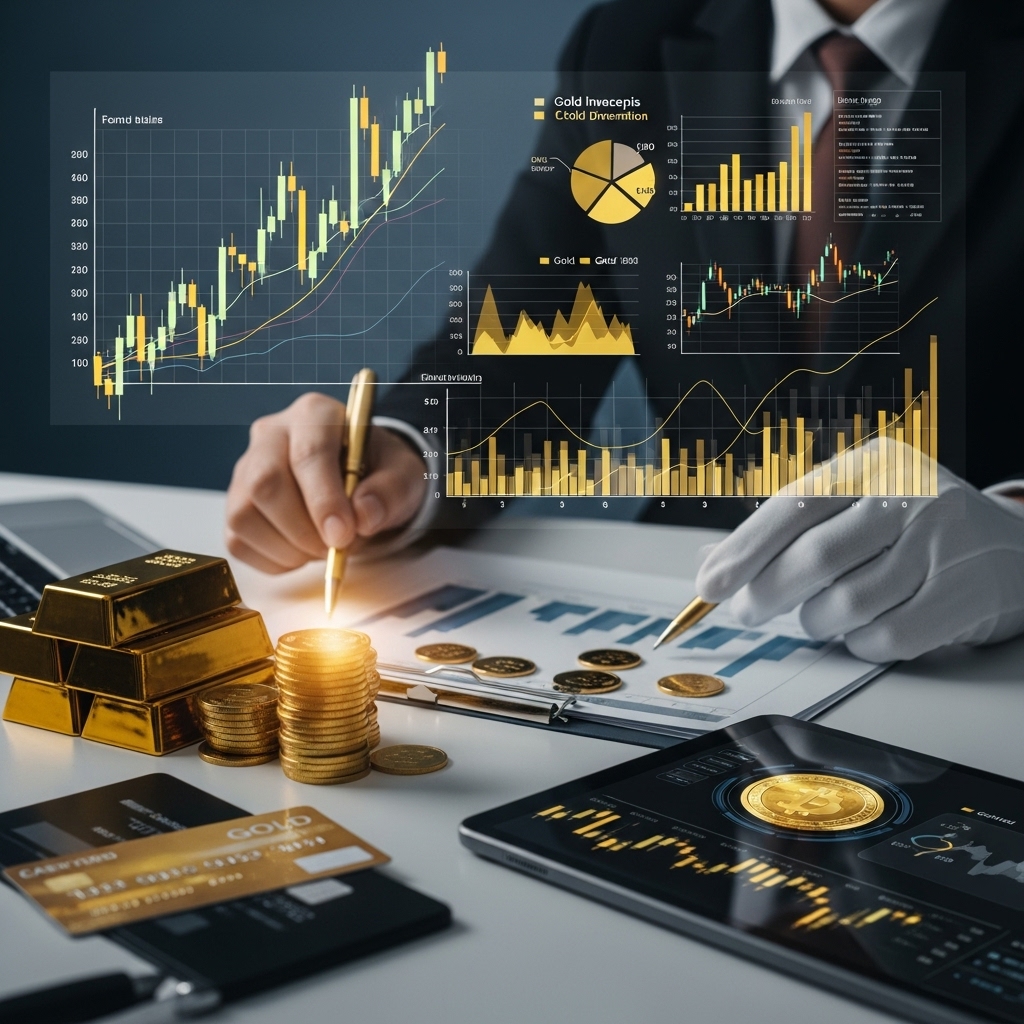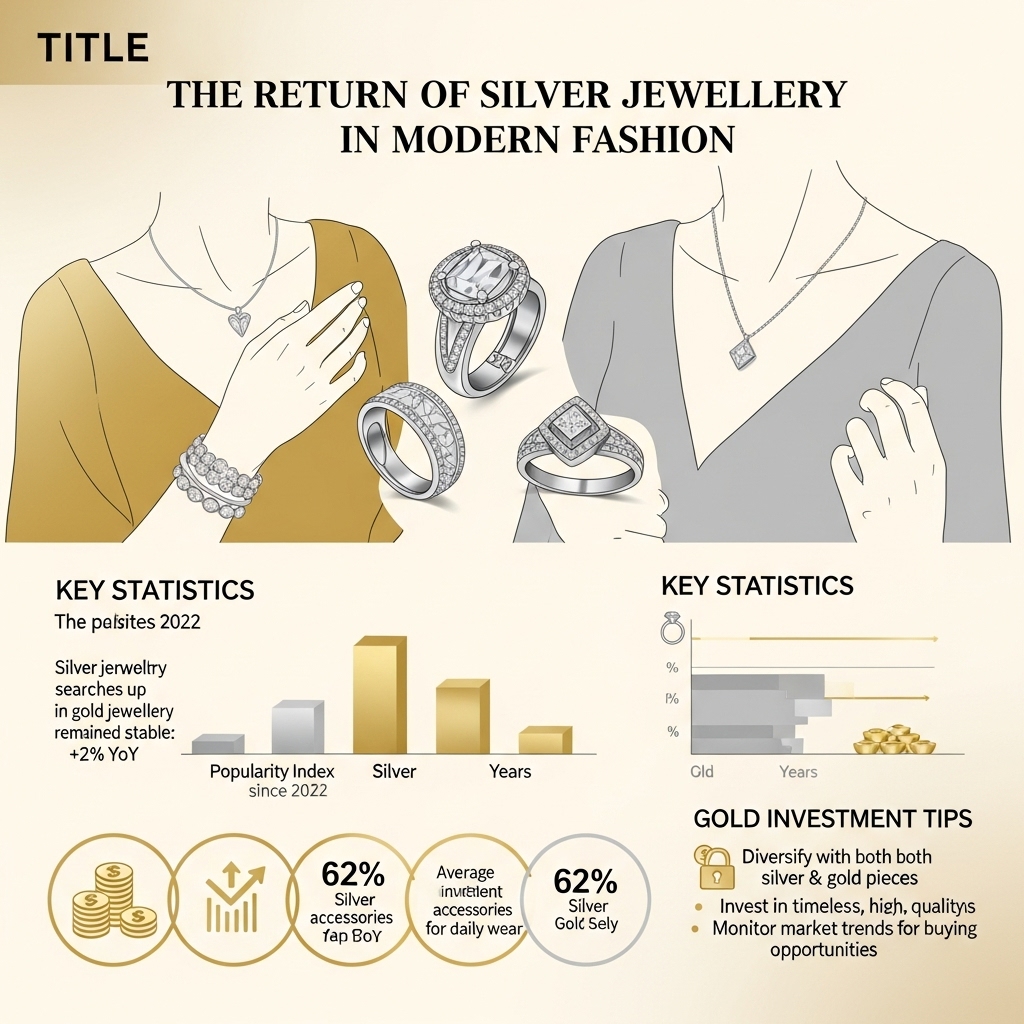The Return of Silver Jewellery in Modern Fashion: What Gold Investors Need to Know
Gold has long been hailed as the king of precious metals, dominating investment portfolios and jewellery boxes alike. Recent market trends only reinforce gold’s allure—buoyed by global uncertainty, gold prices hit impressive highs in early 2024, reminding investors why this metal remains a safe haven asset. But as you keep an eye on your gold holdings, there’s another precious metal making headlines in the world of fashion and, potentially, investing: silver. The resurgence of silver jewellery in modern style is more than a fleeting trend—it’s a signal savvy gold investors can’t afford to ignore.
In this post, we’ll explore the renewed popularity of silver jewellery and what it means for gold investors. We’ll examine why silver is winning over fashionistas and designers, analyze how changing tastes might impact the broader precious metals market, and highlight key financial opportunities and diversifications for your precious metals portfolio. By understanding the evolving landscape, you’ll see how silver’s rising star can complement your gold investments.
Why does this matter for gold investors? Shifts in consumer behaviour often ripple through financial markets. As silver jewellery captures the spotlight, demand for the metal could impact gold-silver price ratios, alter market dynamics, and present fresh avenues for profit and risk management. Keeping ahead of these trends equips you to make smarter, more informed decisions—ensuring your gold investing strategy stays truly golden.
Gold Market Analysis and Key Insights
Surging Demand and Market Performance
In recent years, the gold market has experienced significant growth, fueled by global economic uncertainties and the quest for safe-haven assets. According to the World Gold Council, global gold demand reached 4,741 tons in 2023, a 5% increase from the previous year. This rise correlates with volatility in equity markets and geopolitical tensions, prompting both institutional and retail investors to increase allocations to gold. Simultaneously, central banks around the world have been expanding their reserves. For example, the People’s Bank of China and the Reserve Bank of India collectively purchased over 400 tons in 2023, reinforcing gold’s role as a stabilizing asset.
Current Market Trends
Spot gold prices have demonstrated resilience, consistently hovering between $1,900 and $2,100 per ounce throughout the past year. This stability contrasts with silver, which, despite its resurgence in fashion and design, remains more volatile due to its industrial uses. The gold Exchange-Traded Fund (ETF) market continues to grow, providing easier access for investors and increasing overall market liquidity. Furthermore, the decline of real interest rates globally has made gold increasingly attractive compared to interest-bearing assets.
Benefits and Considerations for Investors
Gold’s investment appeal lies in its ability to hedge against inflation and preserve wealth during turbulent times. Unlike stocks or bonds, gold’s intrinsic value is not tied to the performance of specific industries or currencies, making it an excellent portfolio diversifier. However, investors should consider certain drawbacks: gold does not yield dividends or interest, and its price can be affected by shifts in global monetary policies or sudden changes in demand.
Expert Recommendations
Financial experts advise integrating gold as a strategic component in diversified portfolios. Most suggest allocating 5% to 10% of an investment portfolio to gold, balancing potential risks and rewards. Experts also recommend considering physically-backed gold ETFs for low-cost, liquid exposure and monitoring macroeconomic indicators, such as inflation rates and central bank policies, which significantly influence gold prices.
In summary, while fashion trends highlight silver’s modern resurgence, gold’s enduring status as a wealth-preserving asset ensures its continued relevance for prudent investors seeking to navigate an unpredictable financial landscape.

Gold Investment Strategies and Options
While silver’s resurgence in modern fashion amplifies its appeal, many investors also consider gold for portfolio diversification, wealth preservation, and hedging against inflation. There are several gold investment options, each with unique strategies, benefits, and risks.
Direct ownership involves purchasing physical gold through bullion bars, coins, or jewelry. This tangible approach offers security from counterparty risk, but investors must account for storage, insurance, and liquidity concerns. Gold Exchange-Traded Funds (ETFs) provide easy access to gold’s price movements without the need to handle the metal. ETFs are typically highly liquid and can be bought or sold like stocks, though they incur management fees. Gold mining stocks and mutual funds offer indirect exposure. These often provide higher growth potential but come with elevated risks linked to market volatility and company performance.
Risk assessment and portfolio allocation are crucial in gold investing. While gold acts as an effective hedge during economic downturns, its price can stagnate during bull markets in other asset classes. A prudent approach is to allocate 5–15% of a diversified portfolio to gold, carefully adjusting based on individual risk tolerance, investment horizon, and current market conditions.
Comparing investment methods, physical gold is best for long-term preservation but less liquid, while gold ETFs offer flexibility and ease of transactions. Mining stocks yield the benefit of dividends and leverage to gold prices but are highly susceptible to operational risks.
Market timing requires a thorough understanding of economic cycles. Historically, gold prices surge during market uncertainty and inflationary periods. Investors should consider entering during dips or ahead of anticipated financial volatility rather than chasing price spikes.
Ultimately, selecting an appropriate gold investment strategy requires a balanced view of one’s financial goals, risk appetite, and an understanding of how gold complements silver and other assets in a well-constructed portfolio.
Market Performance and Outlook
Historically, silver jewellery has experienced fluctuating popularity, often overshadowed by gold due to the latter’s perception as a status symbol and reliable investment. In the late 20th and early 21st centuries, gold dominated global jewellery markets, with silver jewellery accounting for less than 15% of total market share in 2000. Over the past decade, however, silver has steadily regained prestige, underpinned by the rise of minimalist and contemporary fashion trends. From 2015 to 2023, global demand for silver jewellery rose by 36%, according to the Silver Institute, reversing prior declines.
Currently, silver jewellery enjoys renewed favour among younger consumers and fashion-forward demographics. Social media platforms and celebrity endorsements have contributed to surging demand, with major retailers reporting double-digit sales growth for silver pieces in 2023. This resurgence is also influenced by economic uncertainty and rising gold prices, which have made affordable alternatives such as silver more attractive.
Looking ahead, the silver jewellery market is projected to maintain strong momentum, with forecasts predicting a CAGR of approximately 7% through 2028. Economic factors, particularly high inflation and fluctuating gold prices, will continue to boost silver’s appeal as both an affordable luxury and style statement. Furthermore, sustainability concerns and the adoption of recycled silver are likely to entice ethically minded consumers, solidifying silver’s status in modern fashion for years to come.
Frequently Asked Questions About Gold Investment
What are the main benefits of investing in gold?
Gold is valued for its ability to preserve wealth during economic uncertainty. It acts as a hedge against inflation, currency fluctuations, and market volatility, offering diversification for investment portfolios.
How do I invest in gold?
Investors can choose from physical gold (bars, coins, jewelry), gold-backed exchange-traded funds (ETFs), gold mining stocks, and mutual funds. Each option offers varying levels of liquidity and risk.
Is gold a safe investment during financial crises?
Gold is often considered a “safe-haven” asset. Historically, when stock markets decline or geopolitical tensions rise, gold prices tend to increase due to increased demand for stable stores of value.
What risks are associated with gold investment?
Risks include price volatility, storage and insurance costs for physical gold, and no yield or dividend returns. Market factors, such as shifts in monetary policy, can also impact gold prices.
How do I store physical gold safely?
Physical gold should be stored in secure, insured facilities like bank safety deposit boxes or specialized vaults. Avoid keeping large quantities at home to minimize theft risk.
How do taxes work on gold investments?
Gold investments may be subject to capital gains and, in some countries, value-added tax (VAT). Taxation depends on the investment vehicle and region, so consult a financial advisor for specifics.

Final Thoughts on Gold Investment
As silver jewellery enjoys a stylish resurgence in modern fashion, it’s important for gold investors to note the shifting consumer trends. While silver captures attention for its versatility and affordability, gold remains a symbol of lasting value and financial security. The growing popularity of silver highlights opportunities for diversification, but gold continues to outperform as a stable, inflation-proof asset in any portfolio. Our recommendation? Consider the fashion-driven momentum behind silver, but maintain gold at the heart of your investment strategy for long-term wealth preservation. Ready to secure your financial future? Explore your gold investment options today and benefit from its enduring appeal—both in style and stability.